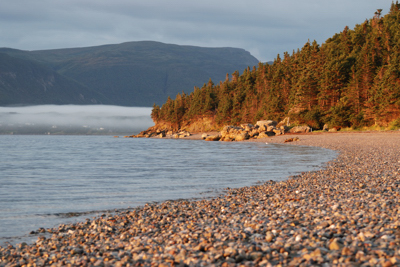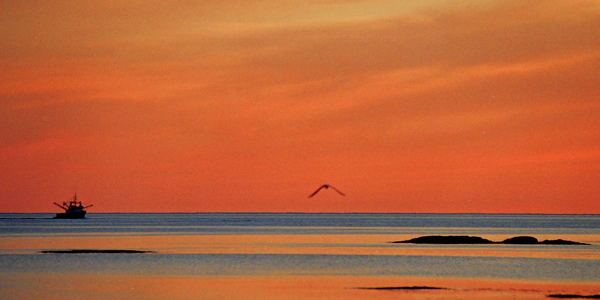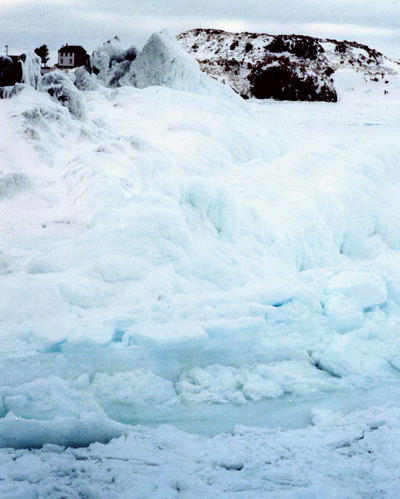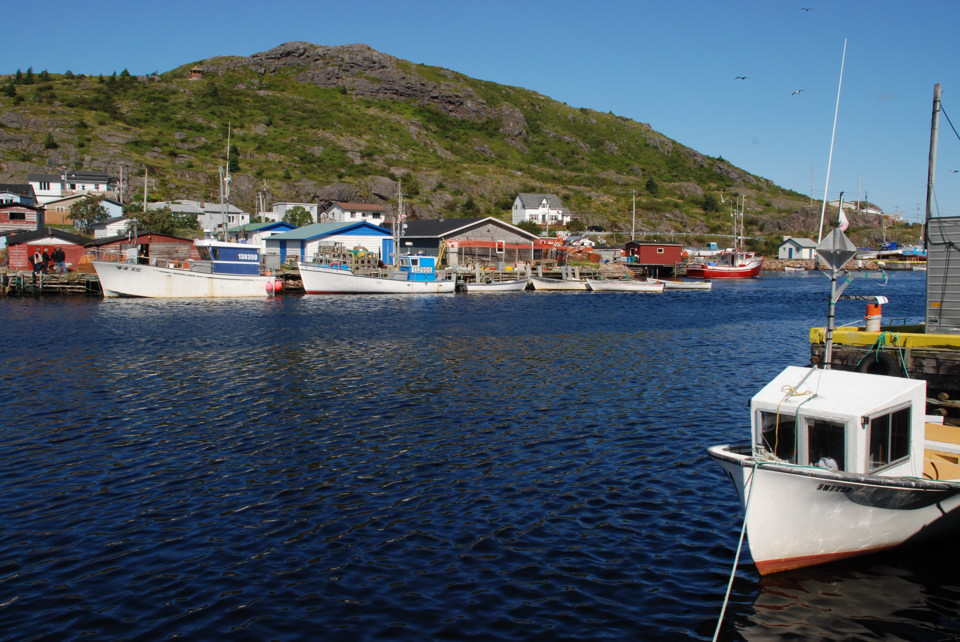Weather and climate

Foggy dew, Blow Me Down Provincial Park, September 2008.
The weather in Newfoundland is an attraction all by itself. In all the years we visited this island, we have experienced a fascinating array of types of weather: fog, cold, rain, wind and snow, but also a lot of sun and warmth. We have seen blizzards sweeping the country in winter at -25°C. On the other hand we have been through a number of heat-waves in summer as well.
The weather is unpredictable. A warm and sunny day can turn cold and drizzly fast. Or otherwise. That’s why locals often say: “If you don’t like the weather, just wait five minutes”.
The weather is not the same for all parts of Newfoundland. When it’s foggy and cold in the southeast, it may well be cloudy and warm in the interior, or even hot in the north.
This will not surprise you, when you consider the size of the island. Newfoundland measures 560 km north-south and 510 km east-west. It covers 5 ½ degrees of latitude. Its southern extremity lies close to the forty-seventh parallel, approximately the same latitude as Paris.
Temperature
Newfoundland has a maritime climate. This means generally that summers are shorter and colder than in a continental climate. The glacial Labrador Current holds July average temperatures in coastal areas around 14°C, but inland averages may climb over 16°C. Occasionally, maximum temperatures can even rise to as high as 30°C. Sunny summer days in Newfoundland, however, are most delightful. With afternoon highs in the low twenties, they are warm enough to be comfortable and yet cool enough to permit vigorous activity. The highest temperature ever recorded on the island is 36.7°C, occuring at Botwood on August 22, 1976.

"A red sky at night is a sailors delight; a red sky in morning is a sailors warning."
For generations Newfoundland fisherman have been able to predict the weather
from watching things in nature. (New Ferroles, 2006)
The tourist season on Newfoundland tends to run from June 1 till the end of August. This does not mean that September or October are not convenient periods to visit Newfoundland. On the contrary, late summer and early fall frequently offer splendid weather conditions. Maximum temperatures can climb to over 15°C at day-time. At night the temperature may well drop below the freezing point. November is usually very wet and stormy.
Winter temperatures in Newfoundland show the day-to-day variability that is characteristic of a stormy maritime climate. Incursions of moist, mild Atlantic air are frequent. There is also a noticeable difference between inland and coastal temperatures.ln the interior, winter temperatures average between -6°C and -10°C, whereas on the southeast coast, where the moderating influence of the ocean is greatest, the winter average is between -2°C and -4°C.
Spring comes rather slowly and is short. There is a big chance on frost at night-time until the first week of June.
Wind and Storm
Newfoundland as a whole has the strongest winds of any Canadian province, with most stations recording average annual wind speeds greater than 20 km/h. Generally, coastal stations have stronger winds than inland stations. Winter is decidedly windier than summer.
Bonavista on the East Coast is the windiest location, with an average annual wind speed of 28 km/h, St. Albans, in the sheltered Bay d'Espoir on the south coast, is the least windy location, with an average yearly speed of 11.5 km/h. Prevailing wind directions are west in winter and west-southwest in summer.
Many of the storms that cross North America during the year from west to east, or develop and intensify off the East Coast of the United States, pass near the island while they move out to the North Atlantic. The result is that Newfoundland has a deserved reputation as one of the stormiest parts of the continent. The severity and frequency of storms is greatest between November and March, although they may occur at any time of the year.
During the summer and early fall, Newfoundland weather is typically less stormy. However, in the fall, tropical storms spawned near the equator and developed in the Caribbean may bring windy, wet weather while they pass by the island before dying or redeveloping in the North Atlantic. Over the past thirty-five years, an average of one tropical storm per year has passed within 300 km of Newfoundland.
Winter cyclones are fast-moving storms (up to 80 km/h) that bring abundant and varied precipitation. They pose a serious threat to fishermen, commercial shipping, and offshore oil and gas exploration activities.

Winter in Twillingate, February 2003
Precipitation
Precipitation averages about 1,120 mm yearly in Newfoundland. Approximately three-quarters of the total precipitation falls as rain and one-quarter as snow . Although precipitation is well distributed throughout the year, it is heaviest in fall, with November being the wettest month. Spring is usually the driest time of the year.
Snowfall dominates winter precipitation. It is heavy, with normal amounts exceeding 300 cm at most places in the province. Along the south coast, however, snowfall totals are in the 200-300 cm range, less than elsewhere because much of the precipitation falls as rain. Some of the heaviest snowfalls (over 400 cm a year) occur in the Long Range Mountains along the west coast.
Fog and Sunshine
The total number of hours of bright sunshine for Newfoundland is usually less than 1600 hours. The summer months are the sunniest, with an average of 187 hours of sunshine a month, about 42% of the total possible. The least sunshine is experienced in December, when the average daily duration is about 2 hours.
The waters off the Avalon Peninsula and over the Grand Banks are among the foggiest in the world. The fogs develop when warm, humid air from the south strikes the cold waters of the Labrador Current. These fogs may occur in all seasons, but, on average, they are most frequent in the spring and early summer when the contrast between sea and air temperatures is greatest.
Surprisingly, the fogs are often accompanied by strong winds. Normally, winds can be expected to disperse fog, but here the fog is frequently so dense and widespread that the winds have little clearing effect.

A pretty hot sunny day at Petty Harbour, September 2008.
